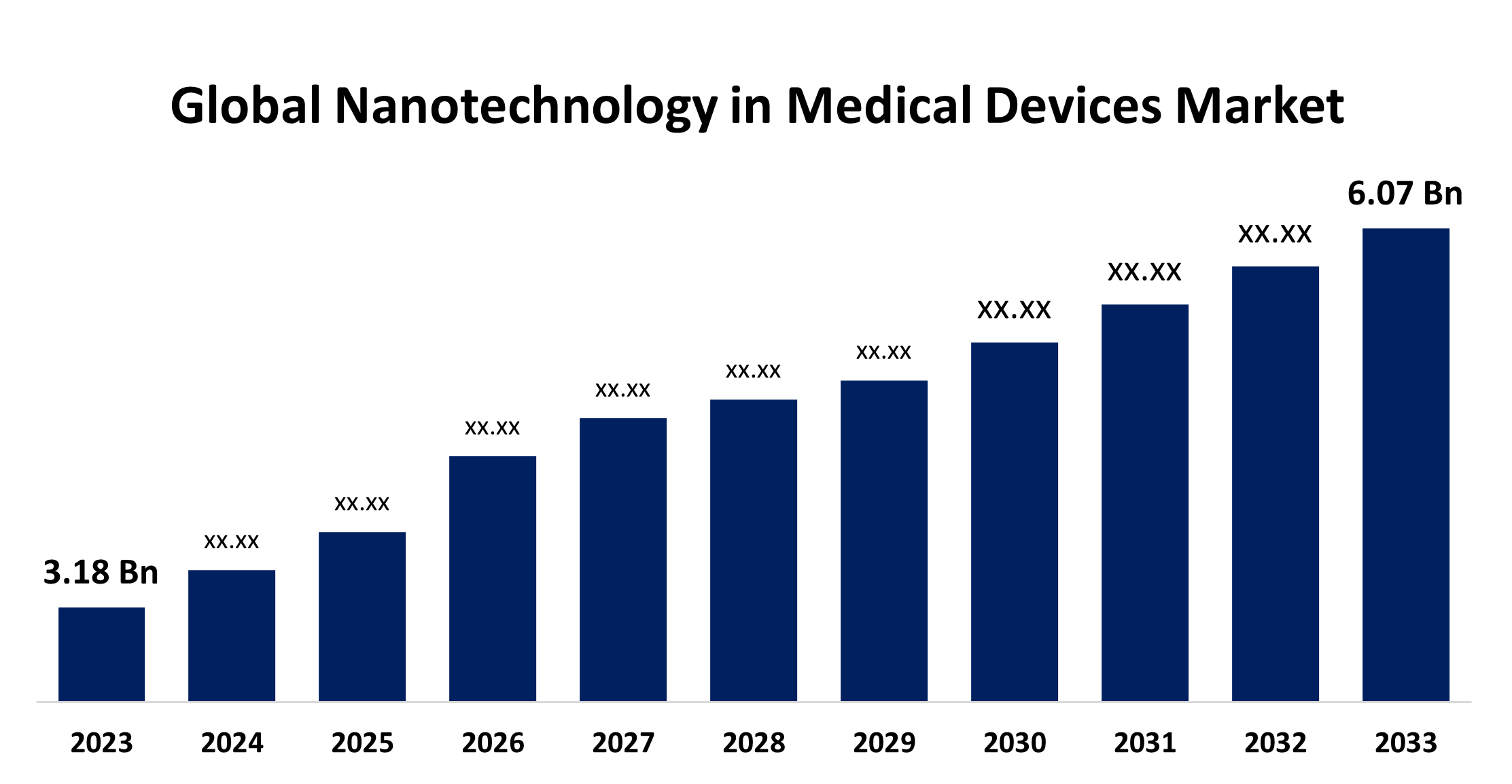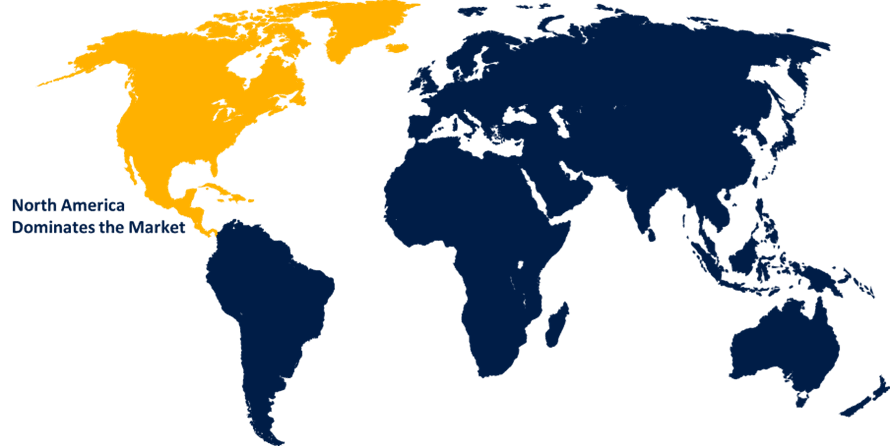Global Nanotechnology in Medical Devices Market Size, Share, and COVID-19 Impact Analysis, By Type (Dental Filling Materials, Implantable Devices, Medical Textiles, and Biochip), By Application (Orthopedics, Dentistry, Neurology, Oncology, and Others), By End-User (Hospitals, Research and Academic Institutes, and Diagnostic Laboratories), and By Region (North America, Europe, Asia-Pacific, Latin America, Middle East, and Africa), Analysis and Forecast 2023 - 2033
Industry: HealthcareGlobal Nanotechnology in Medical Devices Market Insights Forecasts to 2033
- The Global Nanotechnology in Medical Devices Market Size Was Estimated at USD 3.18 Billion in 2023
- The Market Size is Expected to Grow at a CAGR of around 6.68% from 2023 to 2033
- The Worldwide Nanotechnology in Medical Devices Market Size is Expected to Reach USD 6.07 Billion by 2033
- Asia Pacific is Predicted to Grow at the fastest CAGR throughout the projection period

Get more details on this report -
The Global Nanotechnology in Medical Devices Market Size is predicted to exceed USD 6.07 Billion by 2033, growing at a CAGR of 6.68% from 2023 to 2033. The market expansion is driven by several essential characteristic features such as highly targeted and precise medical therapies that can be created with the help of nanotechnology, the ability of materials to interact with biological systems at the molecular level through nanoscale engineering allows for precise medication administration and greatly enhances therapeutic results.
Market Overview
The nanotechnology in medical devices market refers to the utilization of nanoscale materials and technologies and enhance the functionality, precision, and effectiveness of medical tools. Nanotechnology in medical devices, such as disease detection sensors, nanorobots, and nanocoating for durability and biocompatibility, uses nanoscale materials to improve the performance, accuracy, and efficacy of tools and equipment.
Nanosensors in patient health monitoring improve disease management and personalized medicine. The development of smarter, adaptable devices is gaining attention in healthcare. The focus is on developing biocompatible materials and minimizing adverse reactions. Academic and industry collaboration drives innovation, while regulatory agencies ensure safety and efficacy. The adoption of nanotechnology in telemedicine and remote patient monitoring demonstrates a more integrated approach to healthcare. The increasing prevalence of chronic diseases globally drives the market growth.
Report Coverage
This research report categorizes the global nanotechnology in medical devices market based on various segments and regions, forecasts revenue growth, and analyzes trends in each submarket. The report analyses the key growth drivers, opportunities, and challenges influencing the global nanotechnology in medical devices market. Recent market developments and competitive strategies such as expansion, product launch, and development, partnership, merger, and acquisition have been included to draw the competitive landscape in the market. The report strategically identifies and profiles the key market players and analyses their core competencies in each sub-segment of the global nanotechnology in medical devices market.
Global Nanotechnology in Medical Devices Market Report Coverage
| Report Coverage | Details |
|---|---|
| Base Year: | 2023 |
| Market Size in 2023: | USD 3.18 Billion |
| Forecast Period: | 2023 – 2033 |
| Forecast Period CAGR 2023 – 2033 : | 6.68% |
| 023 – 2033 Value Projection: | USD 6.07 Billion |
| Historical Data for: | 2019-2022 |
| No. of Pages: | 268 |
| Tables, Charts & Figures: | 122 |
| Segments covered: | By Type, By Application, By End Use, By Regional Analysis and COVID-19 Impact Analysis. |
| Companies covered:: | Starkey, Stryker, Cochlear Ltd, Boston Scientific Corporation, Abbott Laboratories, Zimmer Biomet, AstraZeneca, LivaNova PLC, Nanospectra Biosciences, Dentsply Sirona, and Other Key Vendors. |
| Pitfalls & Challenges: | COVID-19 Empact, Challenges, Future, Growth, & Analysis |
Get more details on this report -
Driving Factors
The nanotechnology in the medical devices market industry is undergoing rapid advancements owing to the integration of nanoscale materials in various medical applications. These advancements enable smart devices to monitor patient health in real time, improving patient safety and complementing personalized medicine approaches. The industry is expected to see sustained growth due to increased investments in research and collaboration between academic institutions and industry players. Global chronic illnesses raise the need for cutting-edge therapeutic and diagnostic approaches, which propels market growth. Early detection and efficient treatment options are provided by nanotechnology. Government initiatives and funding are boosting nanotechnology in medical devices market. These programs foster innovation and collaboration and support the development of new medical devices, facilitating commercialization.
Restraining Factors
The high cost of nanomaterials, complexity in development, regulatory conflicts, and stability concerns due to alterations in the environment may impede market growth.
Market Segmentation
The global nanotechnology in medical devices market share is classified into type, application, and end-user.
- The implantable devices segment dominated the market with 49.21% of the share in 2023 and is anticipated to grow at a significant CAGR throughout the forecast period.
Based on the type, the global nanotechnology in medical devices market is categorized into dental filling materials, implantable devices, medical textiles, and biochip. Among these, the implantable devices segment dominated the market with 49.21% of the share in 2023 and is anticipated to grow at a significant CAGR throughout the forecast period. The novel application of implantable devices has the potential to completely transform cardiac care by treating congenital heart diseases, improving imaging methods, and strengthening treatments for myocardial ischemia. The use of nanotechnology in cardiac rhythm control devices has the potential to revolutionize the profession by offering more accurate and potent treatments. It is anticipated that as research advances, these developments will spur additional market expansion while providing patients with cardiovascular disorders with better outcomes and novel opportunities.
- The orthopedics segment accounted for the largest market share of 24.05% in 2023 and is predicted to grow at a significant CAGR throughout the projected timeframe.
Based on the application, the global nanotechnology in medical devices market is categorized into orthopedics, dentistry, neurology, oncology, and others. Among these, the orthopedics segment accounted for the largest market share of 24.05% in 2023 and is predicted to grow at a significant CAGR throughout the projected timeframe. Orthopedic diseases are growing more common, which is the main cause of market growth. Orthopedic implants are being improved by nanotechnology, which makes them more robust, biocompatible, and efficient at accelerating bone recovery. Advanced orthopedic solutions are becoming more necessary as conditions like osteoarthritis and fractures become increasingly prevalent. Nanotechnology's potential to enhance implant function and patient outcomes is growing as research advances, which is a major factor in the market expansion in this sector.
- The hospitals segment accounted for the largest market share of 45.21% in 2023 and is expected to grow at a significant CAGR throughout the projected timeframe.
Based on the end-user, the global nanotechnology in medical devices market is categorized into hospitals, research and academic institutes, and diagnostic laboratories. Among these, the hospitals segment accounted for the largest market share of 45.21% in 2023 and is expected to grow at a significant CAGR throughout the projected timeframe. This segment growth is fueled by hospitals' growing investments in cutting-edge medical technology. Hospitals are discovering that nanotechnology may improve therapeutic effectiveness, speed up recovery, and increase diagnostic accuracy. As a result, the use of medical equipment based on nanotechnology, like targeted medication delivery systems and nanoscale imaging instruments, has increased dramatically. The market for nanotechnology in medical devices is expected to rise as hospitals continue to invest in state-of-the-art technologies to provide better patient care and results, reflecting a growing trend in healthcare innovation.
Regional Segment Analysis of the Global Nanotechnology in Medical Devices Market
- North America (U.S., Canada, Mexico)
- Europe (Germany, France, U.K., Italy, Spain, Rest of Europe)
- Asia-Pacific (China, Japan, India, Rest of APAC)
- South America (Brazil and the Rest of South America)
- The Middle East and Africa (UAE, South Africa, Rest of MEA)
North America is anticipated to hold the largest share of the global nanotechnology in medical devices market over the predicted timeframe.

Get more details on this report -
North America is anticipated to hold the largest share of the global nanotechnology in medical devices market over the predicted timeframe. In North America, nanotechnology advancements are improving the precision and effectiveness of medical devices, leading to improved patient outcomes. Regulatory bodies like the FDA are approving nanotechnology-based medical devices, boosting market expansion. Increased capital from government initiatives and private sector investments is driving innovation and development in this field, promoting advanced healthcare solutions.
Asia Pacific is anticipated to grow at the fastest CAGR throughout the projected timeframe. In Asia Pacific, the market expansion is attributed to research initiatives and government-supported programs. Increased awareness of nanotechnology's benefits in healthcare is boosting adoption, enhancing diagnostic and therapeutic capabilities, and positioning the region as a leader in innovation.
Competitive Analysis:
The report offers the appropriate analysis of the key organizations/companies involved within the global nanotechnology in medical devices market, along with a comparative evaluation primarily based on their product offering, business overviews, geographic presence, enterprise strategies, segment market share, and SWOT analysis. The report also provides an elaborative analysis focusing on the current news and developments of the companies, which includes product development, innovations, joint ventures, partnerships, mergers & acquisitions, strategic alliances, and others. This allows for the evaluation of the overall competition within the market.
List of Key Companies
- Starkey
- Stryker
- Cochlear Ltd
- Boston Scientific Corporation
- Abbott Laboratories
- Zimmer Biomet
- AstraZeneca
- LivaNova PLC
- Nanospectra Biosciences
- Dentsply Sirona
- Others
Key Target Audience
- Market Players
- Investors
- End-users
- Government Authorities
- Consulting and Research Firm
- Venture capitalists
- Value-Added Resellers (VARs)
Recent Developments
- In November 2024, EVOQ Nano, a nanoscience company that engineers novel nanoparticles for the life, material, and textile science industries, announced its antimicrobial medical device platform has demonstrated success in a range of applications aimed at combating healthcare-associated infections (HAIs) and improving the performance of implantable medical devices.
Market Segment
This study forecasts revenue at global, regional, and country levels from 2023 to 2033. Spherical Insights has segmented the global nanotechnology in medical devices market based on the below-mentioned segments:
Global Nanotechnology in Medical Devices Market, By Type
- Dental Filling Materials
- Implantable Devices
- Medical Textiles
- Biochip
Global Nanotechnology in Medical Devices Market, By Application
- Orthopedics
- Dentistry
- Neurology
- Oncology
- Others
Global Nanotechnology in Medical Devices, By End-User
- Hospitals
- Research and Academic Institutes
- Diagnostics Laboratories
Global Nanotechnology in Medical Devices Market, By Regional
- North America
- US
- Canada
- Mexico
- Europe
- Germany
- UK
- France
- Italy
- Spain
- Russia
- Rest of Europe
- Asia Pacific
- China
- Japan
- India
- South Korea
- Australia
- Rest of Asia Pacific
- South America
- Brazil
- Argentina
- Rest of South America
- Middle East & Africa
- UAE
- Saudi Arabia
- Qatar
- South Africa
- Rest of the Middle East & Africa
Frequently Asked Questions (FAQ)
-
1. What is the CAGR of the global nanotechnology in the medical devices market?The global nanotechnology in medical devices market is projected to expand at 6.68% during the forecast period.
-
2. Who are the top key players in the global nanotechnology in medical devices market?The key players in the global nanotechnology in medical devices market are Starkey, Stryker, Cochlear Ltd, Boston Scientific Corporation, Abbott Laboratories, Zimmer Biomet, AstraZeneca, LivaNova PLC, Nanospectra Biosciences, Dentsply Sirona, and others.
-
3. Which region holds the largest share of the market?North America is anticipated to hold the largest share of the global nanotechnology in medical devices market over the predicted timeframe.
Need help to buy this report?